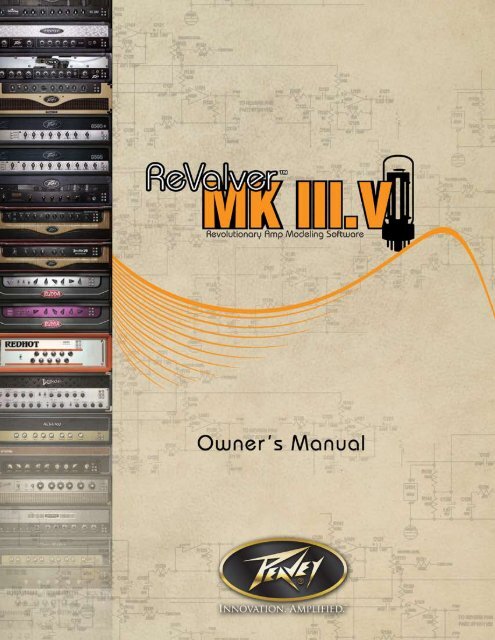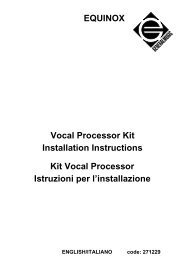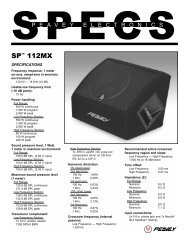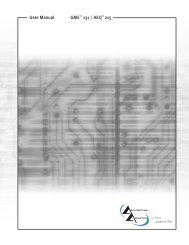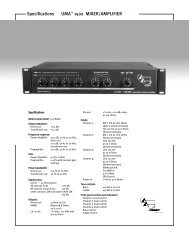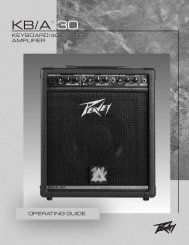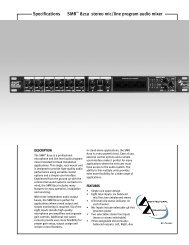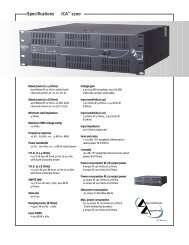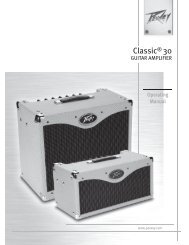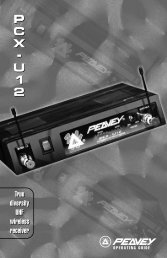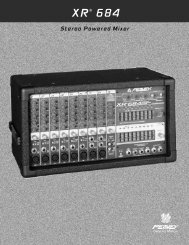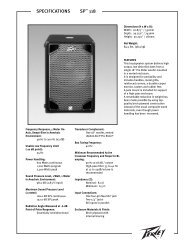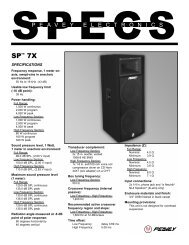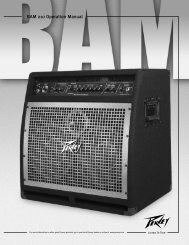Table of Contents Section Page - Peavey
Table of Contents Section Page - Peavey
Table of Contents Section Page - Peavey
You also want an ePaper? Increase the reach of your titles
YUMPU automatically turns print PDFs into web optimized ePapers that Google loves.
<strong>Table</strong> <strong>of</strong> <strong>Contents</strong><br />
<strong>Section</strong> <strong>Page</strong><br />
Introduction/Technical requirements 3<br />
Product Activation and Authorization 4<br />
ReValver Operating Modes<br />
Loading the VST, AU or RTAS Plug-in into the DAW 6<br />
Reaper 6<br />
Sonar 8<br />
Cubase 9<br />
Live 11<br />
Logic Pro 12<br />
Pro Tools 13<br />
Recording the Guitar 3<br />
Working with ReValver MK III.V 18<br />
The Modules 10<br />
Complete amplifiers 20<br />
Pre-amplifiers 27<br />
Power amplifiers 29<br />
Stomp boxes/Pedals 31<br />
Speakers/Cabinets 35<br />
General Effects 36<br />
Miscellaneous Utilities 39<br />
Tweaking Modules 41<br />
MIDI Control and automation 47<br />
Plug in automation 47<br />
Finding a good sound/FAQ 51<br />
License and copy protection 51<br />
Credits and Copyrights 51<br />
2
Introduction<br />
Congratulations on your purchase <strong>of</strong> ReValver MK III.V! ReValver MKIII.V is a revolutionary 64-bit amplifier<br />
modeling s<strong>of</strong>tware that captures the true characteristics <strong>of</strong> vacuum tubes while allowing users<br />
unprecedented control over their tonality and gain structures. ReValver includes 65 incredible linkable sub<br />
modules that model legendary amplifiers, stomp boxes and rack effects, making ReValver MKIII.V the most<br />
advanced virtual amplifier on the planet! This program works both as a standalone using miscellaneous sound<br />
card driver models, or as a VST/AU/RTAS plug-in on various hosts. The program is designed for minimal latency<br />
(input/output delay) which is only limited by the plug-in host.<br />
Technical requirements<br />
Mac Requirements: OS X 10.4 or later, 1 GHz CPU; 512 MB RAM; 1024x768 screen resolution; VST/AU/RTAS host<br />
or sound card<br />
The Live Host <strong>of</strong> ReValver MK III.V requires CoreAudio for playback, and MIDI for MIDI control. (MIDI optional.)<br />
AU plug-in requires AU host.<br />
VST plug-in requires VST host.<br />
RTAS plug-in requires RTAS host.<br />
PC<br />
Windows Requirements: 1 GHz CPU; 512 MB RAM; 1024x768 screen resolution; VST/RTAS host or ASIO/WDM<br />
sound card<br />
OS: Micros<strong>of</strong>t Windows 2000/XP or later<br />
The Live Host <strong>of</strong> ReValver MK III.V require either ASIO, MME, WDM or DirectSound for playback, and MIDI for<br />
MIDI control. (MIDI optional.)<br />
VST plug-in requires VST host.<br />
RTAS plug-in requires RTAS host.<br />
Compatibility issues<br />
While every measure has been made to resolve any compatibility issues with various VST/AU/RTAS hosts and<br />
sound cards, some issues may remain. If you believe you have found a new compatibility problem, please<br />
browse to www.peavey.com/products/revalver. There you will find product updates and user forums.<br />
3
Product Activation and Authorization<br />
When ReValver is installed, it defaults to “demo” mode until activated with a valid ReValver serial number.<br />
Everytime you start ReValver you will be asked if you wish to activate or continue in demo mode. Click on the<br />
“Yes” button to begin the activation process.<br />
The next screen provides details into the product activation process. If you do not yet have a ReValver serial<br />
number, this screen also provides a link to the ReValver web site, where ReValver serial numbers can be<br />
purchased. If you have a serial number, click the “Next” button.<br />
All ReValver serial numbers are associated with a hardware component on your computer. Upon activation,<br />
that serial number is registered along with that hardware component. The following screen reflects the<br />
hardware component that will be used during the activation. To proceed, click the “Next” button.<br />
4
On the following screen, enter your ReValver serial number. If you have an Internet connection, the activation<br />
process will register your copy <strong>of</strong> ReValver online. If you are ready to activate, click the “Next” button.<br />
During the online activation process, you will see the current status <strong>of</strong> the activation in the “Connection log”<br />
window at the bottom <strong>of</strong> the activation screen.<br />
Once the online activation is complete, you will see the following window stating that the activation was<br />
successful. To proceed, click the “OK” button.<br />
To finish the activation process, click the “Finish” button.<br />
5
Product Activation and Authorization Without An Internet Connection<br />
If you do not have an Internet connection on the computer on which you are installing ReValver , choose “This<br />
computer is not connected to the Internet” in the Internet Connection portion <strong>of</strong> the product authorization<br />
window.<br />
When you click the “Next” button, a window will pop up with instructions on how to activate ReValver from<br />
another computer. Carefully follow those instructions to activate ReValver.<br />
ReValver Operating Modes<br />
ReValver has two modes <strong>of</strong> operation: Stand-alone and Plug-in<br />
In stand-alone mode, ReValver runs alone without any other required s<strong>of</strong>tware. If you are looking to use<br />
ReValver as a computer-based live rig or just want to play some guitar, this would be the mode to choose.<br />
In plug-in mode, ReValver runs within a host. If you are recording, your host would be the DAW <strong>of</strong> your choice.<br />
In this case, ReValver would be used as an insert or track effect.<br />
Loading the VST, AU or RTAS plug-in into the DAW<br />
On a Mac, a plug-in in the VST, AU or RTAS format is automatically located by the host and no action needs to<br />
be taken for the host to find the ReValver plug-in. It should be automatically listed among the available plugins<br />
after a rescan.<br />
In Windows, it is possible to install the VST plug-in at any location. To make the VST host aware <strong>of</strong> this location,<br />
it must be manually pointed to. During the installation <strong>of</strong> ReValver, you are given a choice <strong>of</strong> locations to install<br />
the VST (separate from the stand-alone version). We recommend that you install ReValver to a location you<br />
have already used with your host. Most DAWs provide a means to list available VST paths. Below are details for<br />
adding the VST path to various hosts and using ReValver within the DAW:<br />
Reaper<br />
Adding the VST path (Windows)<br />
Menu: Options Preferences Plug-ins VST<br />
Press “Add” (1) to browse to the VST path where the ReValver VST is installed. You then press<br />
“Rescan directory” (2).<br />
6
To use ReValver on a track in Reaper, click on the “fx” button in the track.<br />
In the FX window, click on “VST” in the menu to the left and locate ReValver in the list <strong>of</strong> effects to the left. If you<br />
have a lot <strong>of</strong> VST plug-ins installed, typing “ReValver” in the Filter list at the bottom <strong>of</strong> the window will speed<br />
up your search. Once you have located ReValver, double click to load the plug-in.<br />
7
Sonar<br />
Adding the VST path (Windows)<br />
Menu: Options Global VST Plug-ins (tab)<br />
From the VST Plug-ins tab, click the “Add” button (1) and browse to your plug-in folder. Once you have added<br />
the path, click the “Scan VST Folders” button (2) to rescan for all available plug-ins.<br />
Loading ReValver into a track<br />
To use ReValver on a track in Sonar, right mouse click in the “FX” window <strong>of</strong> the track.<br />
8
In the pop-up menu, navigate to Audio FX VST Folder ReValver. Click on ReValver , this will<br />
load ReValver into an effects slot for the track.<br />
Cubase<br />
Steinberg Cubase is available on Mac and PC. This host only loads VST plug-ins. It does not load AU or RTAS<br />
plug-ins. The ReValver installer automatically installs the VST plug-in in the default location, allowing Cubase<br />
to find it with no additional set-up. On Windows, the ReValver installer allows you to install the VST plug-in at<br />
an alternative location, if you prefer.<br />
Adding the VST path (Windows)<br />
Devices Plug-in Information VST Plug-ins (tab) VST 2.x Plug-in Paths (button)<br />
From the VST PlugIns tab, click the “VST 2.x Plug-in Paths” button<br />
9
In the VST 2.x Plug-in Paths window, click on the “Add” button and browse to your plug-in folder to add your<br />
folder path.<br />
Loading ReValver into a track<br />
Click on the “Insert” bar to open the inserts.<br />
Click on the desired insert to choose the ReValver plug-in from the menu.<br />
10
Live<br />
Adding the VST path (Windows)<br />
Options Preferences File Folder Plug-in Sources section<br />
In order to use a custom folder as a source <strong>of</strong> VST plug-ins in Live, set the “Use VST Plug-in Custom Folder”<br />
option to “On” and then use the “Browse” button below to locate the folder. To complete the process, click the<br />
“Rescan” button to rescan for all available plug-ins.<br />
Loading ReValver into a track<br />
With a track selected in Live, click on the “Plug-In Devices” icon from the left menu. ReValver should show up in<br />
the list <strong>of</strong> available plug-ins.<br />
11
Either double click on ReValver or drag ReValver from the plug-ins list to the device chain in the Track View<br />
Selector.<br />
Logic Pro<br />
In Apple Logic Pro, ReValver will appear as an AU plug-in. All AU plug-ins are installed in a default location and<br />
will after installation appear automatically in the AU hosts plug-in menu. Logic Pro does not support VST or<br />
RTAS plug-ins.<br />
Loading ReValver into a track<br />
To insert ReValver on a track, click on “Inserts”<br />
12
From the menu, under “Audio Units”, select <strong>Peavey</strong> Electronics ReValver MK III.V.<br />
Choose “Mono” or “Stereo” according to your situation.<br />
Pro Tools<br />
Avid Pro Tools only recognizes RTAS (and TDM) plug-ins. The ReValver installer automatically installs the RTAS<br />
plug-in at the default location. Pro Tools will automatically find it after installation.<br />
Loading ReValver into a track<br />
After creating a new track, you insert ReValver by switching to the Mix window.<br />
13
Click on the Insert row where you want to insert ReValver . Select the plug-in by selecting it from the menu.<br />
ReValver will appear as a mono or stereo plug-in depending on your track. ReValver will be found in the<br />
“Harmonic” sub menu.<br />
Recording the Guitar<br />
Recording a Guitar is not as easy as it might seem, but it doesn’t have to be difficult. If your Guitar is not<br />
powered by a battery (and very few are), then it is generating an electrical signal which is not compatible with<br />
most sound cards.<br />
There are common electrical standards between audio gear, and unfortunately the Guitar falls completely<br />
outside those standards because it is passive. The electrical signal from the Guitar is the result <strong>of</strong> the<br />
movement <strong>of</strong> metallic strings over a magnetic pickup, and this is rarely accept able as an electrical source<br />
when you connect it directly to a computer sound card<br />
Connecting the Guitar to the sound card<br />
Here are three ways to connect your Guitar to the computer:<br />
1) The simplest option is to hook it up to the sound card Line-In jack using a suitable connector, usu ally a 1/4”<br />
to 1/8” adapter. The advantage is that you don’t have to buy any additional gear (except maybe the cable<br />
adapter) but the sound is not ideal, probably not even good. The reason for the dull and boring sound is due<br />
to an impedance mismatch.<br />
The sound card input is designed to accept input from electrical devices which have adequate driving signal; a<br />
Guitar does not have enough signal. The input impedance <strong>of</strong> a sound card is in the order <strong>of</strong> a few thousand<br />
ohms (kOhm), while ideally, you want it to be around a mil lion ohms (1 meg ohm).<br />
14
2) Another option is to use a Direct (D.I.) box or Preamp. DI stands for Direct Input or Direct Interface. It is an<br />
electrically powered box that can be used to match the input impedance <strong>of</strong> the sound card and the output<br />
impedance <strong>of</strong> the Guitar. The simplest DI box could cost around $20, but there are boxes that could easily cost<br />
$200 if you want all the “extras,” too. A DI box has a Hi-Z input (“Z” is the unit <strong>of</strong> Impedance; High Impedance<br />
input, in other words). To record, you just plug the DI box directly into the computer Line-In jack.<br />
3) The middle road, which probably won’t cost you anything, but could be almost as good as a DI box, is the<br />
use <strong>of</strong> an ordinary stomp box, which in fact is a sort <strong>of</strong> DI box. It could be a pedal <strong>of</strong> any kind: a distortion pedal,<br />
chorus, echo, etc., as long as:<br />
a) It is electrically powered, and you actually use the battery or power source<br />
b) You use it in bypassed mode, i.e “<strong>of</strong>f”<br />
c) It is not a “true bypass” device (In other words, in “<strong>of</strong>f” mode, if the sound disappears when you remove the<br />
battery, then it is a device that you do want to use as a DI box)<br />
A Guitar pedal is obviously a device which is designed to be used with a Guitar. To record, just plug the pedal<br />
directly into the sound card Line-In. Adjust the output levels on the pedal. A Guitar pedal is an example <strong>of</strong> a<br />
device with a Hi-Z input. If you could find another device with Hi-Z inputs (“Instrument input“) you should try<br />
that as well.<br />
15
4) The best option is, <strong>of</strong> course, to purchase a good quality Digital Audio Interface, such as the <strong>Peavey</strong> Xport .<br />
Look for a device with ASIO (audio stream input/output) drivers, which is an industry standard and will work<br />
well with ReValver MKIII.V. After you install the device, the Audio Devices menu under the File menu will allow<br />
you to choose that device for input and output, then the Control Panel button will be activated, and serve as a<br />
link to your device. Since there are so many available options on the market, it is impossible for us to comment<br />
on the specifics <strong>of</strong> a particular product. Just keep in mind that most ASIO-driven audio interfaces operate in a<br />
similar fashion, and the control panel will enable you to make changes to the buffer size, changing the length<br />
<strong>of</strong> time the computer has to make calculations, and resulting in more or less latency. Generally, the smaller the<br />
buffer size, the lower the latency. However, you will have to experiment with buffer sizes to find the optimum<br />
settings for your computer, based on your processor speed and amount <strong>of</strong> memory.<br />
A word about latency<br />
Latency is a technical term that basically means the time lapse between playing a note and hearing it. When<br />
using ReValver as a stand alone program, you need to set the latency to as low a number as your computer will<br />
allow. If you are using your PC or Mac’s original factory sound card, you are almost guaranteed to have latency<br />
issues. It really does make sense to get a high-quality sound card, and there are many models available at<br />
various price levels.<br />
ReValver by itself does not control how much latency you will experience with the program, neither the<br />
stand-alone nor the plug-in. (In plug-in mode, the latency is controlled entirely by the DAW). To control the<br />
latency in stand-alone mode, you are advised to set the appropriate numbers in the sound card driver.<br />
ReValver provides a shortcut to the ASIO control panel <strong>of</strong> your card. (In the “Audio Devices” menu, select ASIO,<br />
your sound card, then press Control Panel).<br />
The latency is directly proportional to the “sample chunk size.” Short latency equals small chunk size.<br />
Recommended chunk size is 128-256 samples. If the sound is breaking up (choppy sound, stuttering),<br />
increase the buffer size. (Try these standard values: 64, 128, 256, 512, 1024, 2048). It is advisable to start with a<br />
smaller number and gradually increase until the sound is no longer choppy.<br />
16
Recording the Guitar with or without effects?<br />
Should you use hardware compressors, distortion or other effects before you record the signal? It is your<br />
personal preference. If you can’t live without “that special sound,“ then you should probably record it that way.<br />
But when it comes to compression, EQ, reverb and other special effects that could be produced in s<strong>of</strong>tware,<br />
then you should produce it in s<strong>of</strong>tware and not in hardware. That way you can always change your mind<br />
afterward.<br />
To truly access all <strong>of</strong> the incredible tone shaping that ReValver allows, you should take advantage <strong>of</strong> a process<br />
called “re-amping.” In a nutshell, re-amping simply means to record the Guitar dry and then use the ReValver<br />
plug-in to change the tones. In this way, you will have unlimited access to all <strong>of</strong> the amazing tones ReValver<br />
can <strong>of</strong>fer. Of course, as in the paragraph above, if you can’t live without a certain distortion tone, you can still<br />
use ReValver’s effects modules as a rack <strong>of</strong> effects. The sky is the limit and it’s all at your fingertips! There is one<br />
“effect” you generally should use before sampling the signal, namely “limiting.” It is a function which keeps the<br />
signal from clipping digitally in case you happen to use a too strong signal. Some audio interfaces have a s<strong>of</strong>t<br />
limiter built in; however, when you are recording a dry Guitar the presence <strong>of</strong> distortion means you are<br />
sending too hot a signal to the computer. If you are recording a dry Guitar to re-amp, there should be no<br />
distortion whatsoever.<br />
Using 16 bit or 24 bit sampling?<br />
Many sound cards today <strong>of</strong>fer 24-bit sampling at high sample rates. While the CD audio standard is only 16-bit<br />
and still sounds quite good, it makes perfect sense to use as many bits as pos sible during recording. In general,<br />
it is always good thinking to use more bits than you will need in the very end.<br />
16-bit audio gives you about 96 dB <strong>of</strong> dynamic range. 24 bits gives you an additional 48 dB. A high gain preset<br />
in ReValver MK III.V amplifies the signal a lot, probably 40 - 80 dB, and with those levels you would start to hear<br />
the sound card “quantization noise” (bit noise). With more bits there is less digital noise. You will still hear<br />
electrical noise, but that is usually significantly less.<br />
Using 44.1/48kHz, 96kHz or higher?<br />
The higher the better, normally, but in ReValver MK III.V, all vital parts are oversampled to the double-sample<br />
rate to make sure there is a minimum <strong>of</strong> aliasing noise. Aliasing noise, simply put, is an unpleasent background<br />
noise that can occur with any modeling s<strong>of</strong>tware or amplifier when the CPU is asked to do more than it can do.<br />
You should also consider that most good Guitar sounds are very bandwidth-limited and you probably don’t<br />
need the high frequency range that even 44.1kHz sample rate <strong>of</strong>fers.<br />
17
Working with ReValver MK III.V<br />
The title module<br />
At the top <strong>of</strong> the graphical interface <strong>of</strong> the program is a module containing general setup functional ity,<br />
including the Input volume +-16dB adjustment (with pre and post LED indica tors) and Output volume<br />
-32dB adjustment (with post LED indicator). The adjustment knobs can automatically adjust the input and<br />
output volume to 0dB by pressing the “Learn” buttons.<br />
Pressing the gearwheel icon brings up the Options window.<br />
The Title module also hosts the bank & preset management; see below.<br />
Presets and banks<br />
A preset <strong>of</strong> ReValver MK III.V is constructed from one or more sub-modules. The signal path moves down the<br />
path <strong>of</strong> modules from top to bottom. If the “signal splitter” has been inserted, the chain is split into two parallel<br />
chains until they are merged in the “signal merge module.”<br />
There is no restriction on how to combine modules, as they can be “chained” in any combination (although<br />
some combinations are undesirable). The idea is to imitate the behavior and applica tion <strong>of</strong> real-life amps and<br />
effect units.<br />
Normally you would find combinations with this order: Stompbox (if any), Amp, Speaker and Effect (if any).<br />
An amp consists <strong>of</strong> a preamp and a power amp, and you may replace a module in the “Amp” category with a<br />
combination <strong>of</strong> a “Preamp” and “Power Amp.”<br />
Presets are organized in “banks.” To select a preset from a bank, that bank must first be selected from the title<br />
module at the top <strong>of</strong> the chain. A bank and preset can also be selected through MIDI command.<br />
To save a preset or bank in a new position, press “New” beside the drop-down menu. You will be asked to name<br />
it. When you have entered a name, press the “Done” button or the Enter key. To cancel, press the Escape key.<br />
After you rename a preset or a bank, ReValver automatically saves it.<br />
Pressing “Save” will save the current preset or bank into the currently selected position, overwriting the old.<br />
To import or export a preset or a whole bank, press the “Imp.” (import) or “Exp.” (export) but tons.<br />
18
Quality modes<br />
By pressing the gearwheel icon on the title module you can select the Startup quality mode.<br />
The mix-down quality mode forces 64-bit processing at 4x oversampling. This mode fully exposes the qualities<br />
<strong>of</strong> the program, whereas the normal “real time” mode may be a little more noisy and is likely to contain some<br />
aliasing noise (especially in high gain amps).<br />
It is recommended to always use the “mix-down mode” when freezing/rendering or when mix ing a track.<br />
Please be aware that the additional requirements <strong>of</strong> mix-down mode could make the multitracker stutter or<br />
drop out if run at real time. The CPU requirement is more than 5 times that <strong>of</strong> the real-time mode. To switch the<br />
mode, you must restart the VST/AU/RTAS host to allow all instances <strong>of</strong> ReValver to fully reload. Every new<br />
instance <strong>of</strong> ReValver will be started in the current startup mode. In some cases, the sound <strong>of</strong> ReValver can be<br />
different when switching modes. That is because not all features can be accurately expressed in real-time<br />
mode, but only in mix- down mode.<br />
Selecting modules<br />
To insert a module anywhere in the signal chain, right-click your mouse on “click for a new module here.” The<br />
module selector allows you to select modules from their categories, and will display a brief description about<br />
each module.<br />
Moving modules<br />
One <strong>of</strong> the coolest features in ReValver MK III.V is how easy it is to move modules around, totally reconfiguring<br />
the signal chain on the fly. To move a module, simply move the cursor to the right <strong>of</strong> the module over the rack<br />
screw until your cursor turns into a 4-pointed cross, then hold the mouse button down and move the module<br />
where you want it. Release the button and you’re done! Be mindful, however, that not all routing will sound<br />
good. For example, putting your amp directly into a Chorus pedal is not very pleasing to the ear!<br />
Toggling between mono and stereo<br />
Each module can be set individually to process the signal in either mono or stereo. It either merges the<br />
channels or expands them depending on how the previous module is set. Some mod ules, such as REVERB,<br />
VOLUME EFFECTS and DELAY, are set to STEREO by DEFAULT.<br />
If the host (VST, AU, DirectX) has patched ReValver MK III.V on a mono track, all pro cessing will be converted to<br />
stereo.<br />
19
The Modules<br />
Complete amps<br />
The modules in this category are integrated preamps and power amps; thus, no module from the “preamp” or<br />
“power amp” categories is needed along with an “amp” in a ReValver MK III.V preset.<br />
Module name = <strong>Peavey</strong> 6505®<br />
Description = Loud, mean and built for the road, the 6505 was named in celebra tion <strong>of</strong> <strong>Peavey</strong>’s first 40 years,<br />
1965 to 2005. 6505 Series amps feature five 12AX7 preamp tubes and four 6L6GC power amp tubes, with<br />
presence and resonance controls and three-band EQ for taming their notorious tone.<br />
Module name = <strong>Peavey</strong> 6505®+<br />
Description = Adding an extra preamp tube and even more gain to the 6505, the 6505+ represents the<br />
pinnacle <strong>of</strong> metal tone. The 6505 Series amps are the undisputed go-to Guitar amps for scores <strong>of</strong> rock,<br />
hardcore and metal bands due to their raw tone, relentless power and road-proven reli ability.<br />
Module name = <strong>Peavey</strong> Classic® 30<br />
Description = One <strong>of</strong> the most widely used and versatile amps in the music business, the Classic 30 has a<br />
dual-channel preamp, allowing quick variations <strong>of</strong> the tone from vintage blues to modern hard rock to<br />
grunge. The boost switch is particularly use ful in obtaining the more traditional “cranked-amp” tones without<br />
the harshness generated by sending too much low end to the power amp.<br />
20
Module name = <strong>Peavey</strong> 3120 <br />
Description =The Ultimate tone machine. The 3120 rips, with four 12AX7 preamp tubes and four 6L6GC power<br />
amp tubes. The amp is controlled by a master volume pot and independent volume knobs for each <strong>of</strong> its three<br />
channels. The Ultra and Crunch channels have gain controls to further assist in taming this beast. Tone contour<br />
is accomplished through passive controls on the Clean channel, while the Ultra and Crunch channels utilize<br />
active controls.<br />
Module name = <strong>Peavey</strong> Sensation 20<br />
Description = The <strong>Peavey</strong> Sensation is a boutique amp in every sense <strong>of</strong> the word. If your thing is tone, this is<br />
the amp for you. This single channel tone machine boasts three 12AX7 preamp tubes and two EL84 cathodebiased<br />
output tubes, along with pre-gain, treble, middle, bass, post controls and reverb. Drawing on over 45<br />
years <strong>of</strong> <strong>Peavey</strong> amplifier know-how, the Sensation is a true player’s amplifier.<br />
Module name = <strong>Peavey</strong> Masterpiece 50<br />
Description = The flagship <strong>of</strong> the <strong>Peavey</strong> custom shop amps, the Masterpiece is a two channel dream with<br />
three 12AX7 preamp tubes and two fixed-bias 6L6GC output tubes. The Clean channel features volume, treble,<br />
middle and bass controls with a bright switch. The Overdrive channel uses the Clean channel and adds two<br />
stages <strong>of</strong> gain to achieve a very smooth, musical overdrive that ranges from slightly overdriven to thick<br />
overdrive tones. Gain trim, gain and gain level controls and an all-tube reverb add even more tone shaping.<br />
21
Module name = <strong>Peavey</strong> ValveKing®<br />
Description = A true tone monster in its own right, The ValveKing delivers a tone ranging from bluesy clean to<br />
crunchy and classic rock. The amp has a built-in spring reverb and separate tonestacks for the Clean and Lead<br />
channels. The amp’s preamp and power sections use 12AX7 and 6L6GC tubes, respectively. The ValveKing also<br />
features global resonance, presence and reverb controls.<br />
Module name = <strong>Peavey</strong> JSX®<br />
Description = Loaded with three independent channels and comprehensive tonal control, the Joe Satriani<br />
signature JSX puts the full spectrum <strong>of</strong> Guitar tones at your fingertips, starting with a pristine clean channel,<br />
the perfect foundation for layering outboard effects, and including the exclusive FAT switch that adds extra<br />
heft to the Ultra and Crunch channels. The amp also has presence control and the patented resonance<br />
adjustment for the ultimate in tone!<br />
Module name =Budda® SuperDrive<br />
Description = A rock masterpiece! The Budda SuperDrive is ready to go from punchy rhythm tones to creamy<br />
blues tones to full-on metal crunch. With three 12AX7 preamp tubes, one 5u4 rectifier and powered by 2 EL84<br />
power tubes, the SuperDrive II runs the tonal gamut from rich and creamy to modern overdrive. The<br />
proprietary Budda Dual Class Hot Bias preamp circuit combines the best characteristics <strong>of</strong> class A and class AB<br />
to produce lively tones defined by massive dynamics and complex overtones in second and third harmonics,<br />
with plenty <strong>of</strong> separation to let your guitar sing.<br />
22
Module name =Budda® V-Series<br />
Description = The Budda SuperDrive V-20 <strong>of</strong>fers the best in British Class AB guitar amplifier design. The V-20<br />
delivers rich, harmonically complex tone that rewards your playing with exceptional sensitivity to variations in<br />
your pick attack and to subtle changes in playing style. With Budda’s Dual Class Hot Bias preamp circuitry,<br />
three 12AX7 preamp tubes, 6V6GC power tubes and a special thick alternate voicing that boosts mid<br />
frequencies to give your tone added cut and presence in the mix, the SuperDrive V-20 is sure to please even<br />
the most picky guitarists.<br />
Module name =Demon<br />
Description = The Demon is a 3 channel Teutonic terror with five 12AX7AC preamp tubes and a whopping six<br />
EL34/5881/6550/KT88 power tubes that can be intermingled. Channel one produces a sparkly, crystal clear<br />
clean sound. Channel two has two voicings which can be selected with a toggle switch. The (-) mode ranges<br />
from a vintage type clean sound to crunch. The (+) mode <strong>of</strong>fers more gain. Channel three is the high gain<br />
channel for brutal distortion. The Demon has a selectable mid cut feature, assignable to all channels. The mid<br />
cut feature has a compensation control called “level”. The Demon’s master section features dual volume<br />
controls, and global presence and deep control knobs.<br />
23
Module name =Redhot<br />
Description = This Class A British amplifier sports two dual stage channels with completely separate signal<br />
paths, resulting in essentially two vintage amps in one. Channel One has a classic thick voice that screams<br />
when pushed. Channel Two has a tighter character with more upper mids and gain. Featuring four 12AX7<br />
preamp tubes, four EL84 power tubes, and a GZ34 Rectifier, the Redhot is a classic rock standard.<br />
Module name = Flathill<br />
Description = This high-gain rectifier amplifier has 5 modes, Normal/Clean/Modern/Red/Vintage, each with<br />
individual frequency characteristics and gain.<br />
Module name = Basic 100<br />
Description = With one channel for Guitar and one for bass, this “100 watt” amp has a lot <strong>of</strong> bot tom and is<br />
favored for its clean tones. The Guitar and bass channels have different gain and tone stacks. The bass channel<br />
even has a “Deep” switch that shifts the frequency response <strong>of</strong> the Bass knob. On the Guitar channel, the Bright<br />
switch gives you a brighter sound on lower gain.<br />
24
Module name = Fox ACS-45<br />
Description = This amp has three channels, all running at the same time: a Normal, Brilliant and Tremolo<br />
channel. The Tone controls (Bass & Treble) only work on the Brilliant channel. The Tone Cut control removes<br />
some high treble (on all channels), and works like a reversed presence control.<br />
Module name = HomeBrew SE-1<br />
Description = The HomeBrew SE-1 is a low-wattage, single ended amp with two channels. For a low-wattage<br />
circuit it has as many as 3 triode stages for gain. The amp has 2 channels, Clean/Dist.<br />
Module name = The MatchBox<br />
Description = The MatchBox is designed to provide clean to overdriven amplification with a min imum <strong>of</strong><br />
clipping. It has as many as 4 gain stages with considerable attenuation between stages. It has a power amp in<br />
a push-pull configuration but no negative feedback (NFB). The sound is fit ting for both Guitar and bass. This<br />
amp uses a very special tube configuration that gives you an extra bright sound. For additional distortion,<br />
please try any <strong>of</strong> the distortion stomp boxes in front <strong>of</strong> the amp.<br />
25
Module name = ‘62 BluesMaker<br />
Description = Loosely based on a 1962 classic, this amp has 2 channels, normal and tremolo. The original amp<br />
did not have a “Drive” control, but we put one here to modu late the distortion in the power amp.<br />
Module name = ACM 900<br />
Description = This amp is modeled after a “Rock & Roll” amp built with both valve and solid state components.<br />
It has only 1 channel but the two gain knobs control the gain at two stages in the preamp.<br />
Module name = HomeBrew PP-2<br />
Description = The HomeBrew PP-2 is a low-wattage, push-pull amp with two channels and a British-style tone<br />
stack.<br />
26
Preamplifiers<br />
A module from this category is preferably placed before a module from the “power amp” category.<br />
Module name = <strong>Peavey</strong> 6505® preamp<br />
Description = The preamp from the 6505 amplifier. All the tonal control without the power amp section.<br />
Module name = <strong>Peavey</strong> Classic 30® preamp<br />
Description = The preamp section <strong>of</strong> the Classic 30 without the power section.<br />
Module name = <strong>Peavey</strong> JSX® preamp<br />
Description = All the functionality <strong>of</strong> the <strong>Peavey</strong> JSX without the power section.<br />
Module name = <strong>Peavey</strong> ValveKing® preamp<br />
Description = The preamp section <strong>of</strong> the ValveKing amplifier.<br />
Module name = Pre-HB<br />
Description = Simple preamp for clean and slightly overdriven sounds. The preamp goes easily into overdrive,<br />
but distorts gently and relatively cleanly.<br />
27
Module name = Pre-02<br />
Description = This preamp has 2 parallel channels: a triode tube path and a diode clipping path. The tube<br />
sound mixed with diode distortion makes an interesting and dynamic mix as the two components deliver two<br />
different overtone spectra.<br />
Module name = ‘62 BluesMaker preamp<br />
Description = This preamp was taken directly from the BluesMaker ‘62 amp. It contains both the clean and<br />
tremolo channels, including the tremolo controls.<br />
Module name = Basic 100 bass preamp<br />
Description = This is the bass channel preamp in the Basic 100. The tone section does not include a mid control,<br />
as the original does not have one. The Deep switch lowers the frequency <strong>of</strong> the bass control.<br />
Module name = Basic 100 Guitar channel preamp<br />
Description = This is the Guitar channel preamp from the Basic 100. It is rather clean due to its dual 2 triodes,<br />
neither <strong>of</strong> which typically saturates.<br />
Module name = ACM 900 preamp<br />
Description = This is the preamp section from the ACM 900. The two gain knobs control the gain in two places<br />
in the chain.<br />
28
Module name = Flathill Modern preamp<br />
Description = This is the Modern channel preamp from the Flathill. Very high gain and bright.<br />
Module name = Flathill Normal Red preamp<br />
Description = This is the Normal Red channel preamp from the Flathill. This high-gain preamp has a presence<br />
control, which usually sits in the power section, but gives extra control over the brightness.<br />
Power amplifiers<br />
A module from this category is preferably placed after a module from the preamp category.<br />
Module name = <strong>Peavey</strong> 6505® power amp<br />
Description = The 4 x 6L6GC power amp section from the <strong>Peavey</strong> 6505 amplifier.<br />
Module name = <strong>Peavey</strong> Classic 30® power amp<br />
Description = The Classic 30’s power amp section is pure EL84 heaven. By decreasing the drive on the preamp<br />
and increasing the level <strong>of</strong> the power amp, you can achieve great EL84 saturation.<br />
Module name = <strong>Peavey</strong> ValveKing® power amp<br />
Description = The ValveKing ‘s power amp section features the classic 4 x 6L6 lineup. The ValveKing, however,<br />
adds the patented <strong>Peavey</strong> Resonance control, as well as a Presence control.<br />
29
Module name = M-998<br />
Description = This simple power amp uses 2 triodes in series for extra gain, and also uses a pair <strong>of</strong> tonal<br />
character filters that can be tweaked in the Tweak GUI.<br />
Module name = Standard Power Amp #2<br />
Description = This power amp has a standard push-pull end stage, but is not driven by the usual Long Tail Pair<br />
(LTP). It does have a “clean” switch for less drive and slightly different tonal char acter.<br />
Module name = ‘62 BluesMaker power amp<br />
Description = This power amp is taken directly out <strong>of</strong> the ‘62 BluesMaker. It has a drive and pres ence control,<br />
and has a standard Negative Feedback Loop (NFB) to which the presence control is attached. The NFB shapes<br />
the distortion character <strong>of</strong> the power stage.<br />
Module name = Basic power amp<br />
Description = This power amp is taken directly out <strong>of</strong> the Basic 100. Just like the original amp, the power<br />
section has only a master control. The Negative Feedback Loop (NFB) shapes the distortion character, and can<br />
be adjusted in the Tweak GUI. For an explanation <strong>of</strong> the Tweak GUI, see page 41.<br />
Module name = ACM 900 power section<br />
Description = This power amp is taken directly out <strong>of</strong> the ACM 900.<br />
Module name = Flathill power section<br />
Description = This power amp is taken directly out <strong>of</strong> the Flathill.<br />
30
Stomp boxes / pedals<br />
A module from this category is usually placed before an amp module. They are designed to shape the sound<br />
before it is colored by the amp.<br />
Module name = Budda® Budwah <br />
Description = The Budwah is one <strong>of</strong> the most sought-after wah-wah pedals ever made, designed with tightly<br />
focused tone sweep and an outstanding vocal-like quality. At bass settings (heel rocked back), the Budwah<br />
tone is thick and honky without losing clarity <strong>of</strong> the note. When fully depressed, the highs roll <strong>of</strong>f to a<br />
frequency that isn’t piercing like many other wahs.<br />
Module name = Gatekeeper<br />
Description = The Gatekeeper is a noise gate that relies on tubes for the actual gating, ensuring that the attack<br />
will be available at your slightest touch, even when closed. It has adjustable attenuation, threshold, speed and<br />
brilliance. For additional adjustment you can also use the “second learn mode” and strike a normal chord for<br />
automatic setup.<br />
Module name = OverDriver<br />
Description = This stomp box is wired somewhat like a Guitar amp, in that it uses 3 stages <strong>of</strong> diode distortion.<br />
The “Turbo” acts like a “Master,” adding some extra gain before the last stage. This stomp box could be used to<br />
drive a speaker by itself.<br />
Module name = Chorus CS-1<br />
Description = This is a versatile stereo chorus with adjustable speed and modulation depth, ste reo width,<br />
feedback, delay and 3 individually adjustable filter bands on the wet signal. A chorus can be used to enrich<br />
the sound.<br />
Module name = ACS-CS1 compressor<br />
Description = This compressor is used to even out the volume so that the lower levels do not com pletely<br />
disappear, making the s<strong>of</strong>t sounds louder and the loud sounds s<strong>of</strong>ter and adding a certain sustain.<br />
31
Module name = ACS-LM3 limiter<br />
Description = A limiter is a specially tailored dynamics compressor. This particular limiter com presses the<br />
sound by a factor <strong>of</strong> 50:1 over the given threshold. It will stop sounds or transients over this threshold, limiting<br />
the output volume.<br />
Module name = Slow Grow SG-1<br />
Description = An auto swell effect tracks the notes you play and removes the transients to make the music<br />
sound like it’s being played backwards.<br />
Module name = Octapus Octaver<br />
Description = Behind every great tone is another tone waiting to come out. With Octapus you can release this<br />
sub octave, taken from and added to your melody. The Octapus is a tight and accurate octaver stomp box that<br />
works best when you play one note at a time. Be careful with chords or it will not sound as expected.<br />
Module name = FL-Duo flanger<br />
Description = This flanger effect mixes a varying, delayed signal with the original signal to produce a series <strong>of</strong><br />
phase cancellations. These “notches” make up the sound <strong>of</strong> the flanger. The FL-Duo is actually two flangers.<br />
Except for the mixing controls, they share the same knobs.<br />
Module name = Texas Treble Maker<br />
Description = The Texas Treble Maker is a treble booster whose purpose is to equalize the frequency spectrum<br />
<strong>of</strong> the Guitar to make the distortion smooth. The overtones <strong>of</strong> most sounds are progressively fainter the<br />
higher up the spectrum they are. This means that the distortion a sound generates in a distortion circuit<br />
mainly originates from the overtones <strong>of</strong> the lowest frequencies, placing the frequency range <strong>of</strong> the distortion<br />
compo nents in a particular place <strong>of</strong> the spectrum. A treble booster is designed to reshape the clean sound so<br />
that the distortion components originate in equal amounts from each overtone. The result is a much<br />
smoother distortion, and <strong>of</strong> course more <strong>of</strong> it!<br />
32
Module name = The Sher’ff<br />
Description = The Sher’ff stomp pedal is a tough but versatile distortion effect. Loosely modeled after a<br />
1980s-era cousin, it’s perfect for blues and rock either by itself or with a clean amp channel.<br />
Module name = Re-Lay 2 delay<br />
Description = The Re-Lay 2 is a double delay with a lot <strong>of</strong> options. You can set the volume <strong>of</strong> each tap, plus 2<br />
individual filters per tap.<br />
Module name = Re-Lay 4 delay<br />
Description = The Re-Lay 4 is a quadruple delay with a lot <strong>of</strong> options. You can set the volume <strong>of</strong> each tap, plus 2<br />
individual filters (in the Tweak GUI) per tap. See page 41 for an explanation <strong>of</strong> the Tweak GUI.<br />
Module name = Greener<br />
Description = A classic, yet so simple. This late ‘70s solid state stomp box utilizes a diode clipping circuit,<br />
shaped by pre and post filtering for optimal smooth overdrive/distortion.<br />
Module name = Driver<br />
Description = This is a very versatile stomp box that delivers anything from smooth overdrive (with “Blues”<br />
turned up) to a heavily distorted and overloaded sound (“Gain” and “Muffler” turned up high). The module<br />
uses a modified amp tone stack that allows for heavy mid scooping, great for blues and rock & roll.<br />
33
Module name = MagnaVibe<br />
Description = Not to be confused with Tremolo, a vibrato is a frequency modulator that produces an effect<br />
similar to the sound you hear when you bend the string up and down, changing its pitch. This vibrato allows<br />
you to select a rate between 0 and 10 Hz, as well as a general depth. A knob for “delay” allows the vibrato to<br />
kick in after you pluck the string, making it more transparent when you play fast. Two modes are available, a<br />
“standard digital”, and an emulation <strong>of</strong> a certain “magnetic” stereo amp.<br />
Module name = Tremolo<br />
Description = A tremolo is an amplitude modulator. This effect “rotates” the volume at the range <strong>of</strong> 0-10 Hz.<br />
Two variants are included: the classic “digi tal” tremolo (multiplying the signal with a sine) and the even more<br />
classic “tube bias” tremolo (adding a sine to the bias <strong>of</strong> a tube, partly saturating the signal). The tube bias<br />
variant adds a nat ural overtone and clarity. The digital variant can adjust the up/down slope <strong>of</strong> the transition<br />
from s<strong>of</strong>t to pulsing.<br />
Module name = Wow-Wah!<br />
Description = A Wah pedal is a low-, high-, or band-pass filter with adjustable frequency. At the point <strong>of</strong> cut <strong>of</strong>f,<br />
there is a peak with adjustable resonance, making the Guitar sound “waaaoooowwwoooaaa”. The resonance<br />
has similarities with the human mouth, hence the name. The frequency can be controlled either by a MIDI<br />
pedal (or the main knob) or by auto matic rotation. The resonance can range between any 2 frequencies <strong>of</strong><br />
your choice. An extra knob adds overtones that enhance tonal clarity.<br />
Module name = BassBox<br />
Description = This is a distortion pedal with a harmonic spectrum tailored for bass Guitar. The even har monics<br />
are stronger than the odd, making the distortion very smooth and borderline “clean.” A sec ond gain knob<br />
allows ordinary diode clipping (somewhat asymmetrical). This module can be used to add small amounts <strong>of</strong><br />
color and spice to the bass sound.<br />
34
Speakers / cabinets<br />
A module from this category is usually placed after any amp module.<br />
Module name = Convolution speaker simulation<br />
Description = This module uses real-time convolution to mimic actual speaker and cabinet setups.<br />
Convolution can be very CPU-intensive so there are 2 optimization options, “Resample” and “Hi-Res.” Forcing<br />
downsampling <strong>of</strong> the signal reduces the CPU utilization to an amazing 25%, while still retaining virtually the<br />
same tonal quality. (This is possible because Guitar speakers generally do not have a frequency range <strong>of</strong> more<br />
than 5-6 kHz.) The available speakers and cabi nets were sampled with several microphones placed at varying<br />
angles. One sampling (an “Impulse Response”) is a fixed moment in time and cannot be adjusted. The Load<br />
button allows you to import your own Impulse Responses in .wav format.<br />
Module name = Speaker Construction Set (SCS)<br />
Description = Select from any <strong>of</strong> the predefined speaker models and put them in a cabinet with a physical size<br />
<strong>of</strong> your choice. This simulated speaker cabinet is then miked by any <strong>of</strong> the 20 micro phone configurations. (This<br />
technique is considerably less CPU-intensive than the RIR convolu tion module.) Remember, ReValverMKIII.V<br />
is capable <strong>of</strong> building virtual speaker cabinets that really cannot exist in the physical world, and depending on<br />
which components and settings you change, you could end up with some very “unique” sounds.<br />
35
General effects<br />
Module name = <strong>Peavey</strong> VC/L-2<br />
Description = The <strong>Peavey</strong> VC/L-2 is an all-tube, dual channel Valve Compressor/Limiter, featuring the exclusive<br />
OptoDynamics system. With OptoDynamics, compression and limiting is much more natural and transparent<br />
than with solid-state designs, as there are no solid-state opto-isolators, opto-couplers, or opto-diodes. The<br />
“heart” <strong>of</strong> this design features an EL84 tube and two 12AX7s (four stages) for each channel. The output stage <strong>of</strong><br />
each channel is a “power amp” design that uses a two-stage 12AT7 tube, which results in a +20 dBm output<br />
capability. Whether you need to produce smooth vocals, fix a lifeless snare drum, erase muddy lows from a<br />
bass, or add “punch” to an acoustic guitar performance, the VC/L-2 OptoDynamics system provides complete<br />
management over your audio dynamics.<br />
Module name = 8Q<br />
Description = An eight band parametric filter with adjustable frequency, gain and Q in seven types: high shelf,<br />
low shelf, high pass, low pass, band pass, notch and peak. Each band can be either a first order or second order<br />
IR filter. (Please note that first-order filters cannot represent EQ, band pass or notch curves.)<br />
Module name = 3Q<br />
Description = Triple parametric filters with adjustable frequency, gain and Q in seven types: high shelf, low<br />
shelf, high pass, low pass, band pass, notch and peak. (Please note that first-order filters cannot represent EQ,<br />
band pass or notch curves.)<br />
Module name = ACS R1 Stereo Reverb<br />
Description = Stereo reverb designed to be placed last in the chain to give ambience or width to the result,<br />
with adjustable echo, pre-delay and room size. Three filters can be programmed to shape the char acter <strong>of</strong> the<br />
wet signal.<br />
36
Module name = ACS R2 Stereo Reverb<br />
Description = Stereo reverb designed to be placed last in the chain to give ambience or width to the sound,<br />
with adjustable pre-delay and room size. Three filters can be programmed to shape the character <strong>of</strong> the wet<br />
signal. This reverb is thicker than the Reverb R1; it also has different default filter parameters.<br />
Module name = Ph2 Phaser<br />
Description = Phasing works by mixing the original signal with one that is phase shifted. This phaser features a<br />
feed back and width control for stereo effects.<br />
Module name = SCH-1B Noise gate<br />
Description = A noise gate is a simple way to get rid <strong>of</strong> noise in the signal. The traditional way this effect works<br />
is by lowering the volume <strong>of</strong> the signal when the signal itself becomes very weak. The SCH-1B is different in<br />
two ways. First, this noise gate does not operate on a closed-only or open-only basis, but is variable. Second,<br />
SCH-1B does not affect the actual “volume” but continuously changes the filter param eters <strong>of</strong> an intelligent<br />
filter circuit. You may notice that the noise gate is half-closed when playing s<strong>of</strong>tly. Compared to traditional<br />
noise gates this has the effect <strong>of</strong> being perfectly responsive. The noise gate has four separate bands, and the<br />
fourth has an adjustable frequency.<br />
Module name = Stereo widening effect<br />
Description = This module combines ambience, stereo widening and exciter/enhancer effects to give your<br />
tone a wider, fuller sound with more presence. The enhancer operates by delaying the lower frequencies to<br />
allow the high frequencies to come first, giving the sound a touch <strong>of</strong> presence and clarity. Because <strong>of</strong> the<br />
delay, the enhancer may appear to add “distance” to the sound. You can blend the enhancement with the mix<br />
control. The widen ing effect applies a rotating phase distortion to each channel, and in combination with the<br />
ambience component you can place your audio in a rich virtual room.<br />
37
Module name = Channel Delay<br />
Description = This module can delay the left and right channels 0-100 ms independently (each channel can be<br />
adjusted +-16dB). With the Ambiance option engaged, the module acts as if the time delay repre sents a<br />
distance in a room. The farther away from the source a channel is, the fewer high frequen cies and less volume<br />
it has.<br />
Module name = VST host module (Only compatible with VST and AU operation, does not operate with RTAS<br />
hosts)<br />
Description = This module does not provide any effect or signal processing by itself, but simply allows you to<br />
load a third-party VST plug-in and run it as a regular ReValverMK III.V module. This allows you to use your<br />
favorite plug-in inside <strong>of</strong> the ReValver MK III.V system. VST Plug-In Tech nology by Steinberg.<br />
Note: While <strong>Peavey</strong> makes every effort to ensure compatibility with a wide range <strong>of</strong> VST plug-ins, occasionally<br />
combining certain VSTs will require more CPU power than some computers are capable <strong>of</strong> providing and may<br />
result in unstable performance. Always save your preset before loading a third-party VST plugin into the VST<br />
host module.<br />
Module name = CS3 Tube Compressor<br />
Description = A compressor is used to even the volume so that the lower levels do not com pletely disappear.<br />
Many music pr<strong>of</strong>essionals believe that a tube compressor sounds “warmer” than a solid-state variant due to<br />
the slight saturation <strong>of</strong> the tubes and because the transformer adds a subtle touch <strong>of</strong> “crunch.”<br />
Module name = CS2 Compressor<br />
Description = A compressor is used to even the loudness so that the lower levels do not com pletely disappear.<br />
It will make any distortion module distort for longer.<br />
38
Module name = Gr8 Graphical equalizer<br />
Description = This simple 8 band graphic equalizer has frequency bands placed strategically for bass and<br />
Guitar. The bands can be adjusted manually by pressing the “T” button. Pressing “R” will reset the band.<br />
Module name = Convolution Reverb<br />
Description = A convolution type reverb which uses pre-sampled impulses as source templates. The sound<br />
and reaction <strong>of</strong> the original sampled reverb is what you hear in C-Verb. You can load your own *.wav samples<br />
with the “load” button, or select a factory sample from the list.<br />
Miscellaneous utilities<br />
Module name = Signal splitter<br />
Description = The signal splitter divides the signal into 2 streams. Each runs in parallel using its own set <strong>of</strong><br />
modules. In the “signal merge” module, these two streams are mixed into one signal again. You can only use<br />
signal splitter once per preset.<br />
Module name = Frequency analyzer<br />
Description = The frequency analyzer can scan the audio in real time and present the frequency content on a<br />
live display. The update speed can be switched between 50 ms and 500 ms. The analyzer can create up to<br />
three snapshots and overlay them over each other. By hovering your mouse over the graph you can get an<br />
accurate readout <strong>of</strong> that position. The anti-aliased display yields a very accurate picture.<br />
39
Module name = Leveler<br />
Description = A utility module that can be inserted wherever you wish to monitor or change the volume<br />
levels. The module monitors both the left & right channels. This module has a volume adjust and a “Learn”<br />
button to automatically adjust level to 0dB.<br />
Module name = Stereo Levels adjust<br />
Description = Same as “Leveler” module, but with a control knob for each channel. This utility module can be<br />
inserted wherever you wish to monitor or change the volume levels. The module monitors both the left &<br />
right channels. This module has a volume adjust and a “Learn” button to automatically adjust level to 0 dB.<br />
Module name = Tuner<br />
Description = Guitar tuner with two simultaneous displays, needle and strobe. With anti-aliased graphics, this<br />
tuner displays your tuning with incredible accuracy. The “A” is adjustable between 425 Hz and 455 Hz. Never<br />
go out <strong>of</strong> tune again!<br />
Module name = Simul-Tune<br />
Description = This is not one but six independent strobe tuners running at the same time, one assigned to<br />
each <strong>of</strong> a Guitar’s six strings. The tuning is presented in strobe form and you can adjust each string’s tuning<br />
chromatically. The brightness <strong>of</strong> the strobe indicates the confidence level <strong>of</strong> a frequency in that particular<br />
range (i.e. dark display = not even close).<br />
Module name = Single tonestack<br />
Description = This module only contains one tone stack with Bass, Mid and Tre ble knobs to adjust the filter<br />
aspects <strong>of</strong> any <strong>of</strong> the included tone stacks <strong>of</strong> ReValver MK III.V. (The Foxy tonestack does not use the Mid<br />
knob.)<br />
40
Module name = Single triode<br />
Description = This module contains a single triode tube with no filters, with a level adjust ment before and<br />
after the tube. Using a couple <strong>of</strong> these in a series is like building your own amp!<br />
Tweaking modules<br />
One <strong>of</strong> the most powerful features <strong>of</strong> ReValver MK III.V is the ability to tweak each parameter <strong>of</strong> a module other than the<br />
usual knobs and buttons on the front <strong>of</strong> the module. In an effort to explain the Tweak mode in ReValver, we’ve written<br />
some short explanations <strong>of</strong> each tweak option in the tube tweak GUI.<br />
It takes years to learn tube amplifier engineering, so the awesome “tweakability” <strong>of</strong> ReValver MKIII.V will keep even the<br />
most experienced valve amplifier engineer busy for hours. Users who don’t have any experience with tube amps can use<br />
ReValver to learn about how tube amplifiers work.<br />
Press the “+” but ton on the module, or select “Tweak Module” on the module menu to bring up the general Tweak GUI.<br />
The Tweak GUI is a general GUI that holds specialized tweakable components that differ from module to module. Some<br />
features include Frequency Analyzer, Oscilloscope, Total Harmonic Distortion analysis and save Impulse Response.<br />
The Frequency Analyzer runs a frequency response test <strong>of</strong> the module in question. It does so by inserting a<br />
short “pulse” and performing a FFT (Fast Fourier Transform) frequency analysis <strong>of</strong> the out put. Please note that<br />
such techniques may not yield expected results in non-linear modules such as distortion modules. The Frequency<br />
Analyzer also accurately displays the phase response <strong>of</strong> the module. The analyzer window is displayed<br />
in logarithmic mode with the lower frequency shown in high resolution. This emphasis can be adjusted via<br />
the slider at the bottom <strong>of</strong> the window.<br />
41
The Total Harmonic Distortion (THD) analyzer displays the relationship between the input sound and the<br />
distorted output sound.<br />
The Oscilloscope view illustrates how a module alters the sine wave. It is available for each module as a whole,<br />
and for any tube component there<strong>of</strong>.<br />
42
You can save the Impulse Response (IR) <strong>of</strong> a module to a .wav file in 44.1 kHz stereo. The impulse response is<br />
practically the same view as the frequency analyzer, but this tool allows you to save the response to disk. This<br />
IR can be used in the convolution speaker module (or any other IR plug-in by third party manufacturers) and<br />
can be very useful capturing a “filter” or a “sound” <strong>of</strong> any module in ReValver MK III.V, or any VST plug-in in the<br />
VST module. You can even capture the sound <strong>of</strong> a third party speaker simulator from another VST plug-in and<br />
run it inside <strong>of</strong> the speaker convolution module!<br />
All modules <strong>of</strong>fer some editing features and may include: tubes (and tube configuration), tone<br />
stack (filter collection), filter coloring, rectifier properties, transformer properties, negative<br />
feedback, speaker cabinet, microphone and loudspeaker.<br />
43
The Tube Tweak GUI<br />
One <strong>of</strong> the most powerful features <strong>of</strong> ReValver MK III.V is the detail and number <strong>of</strong> parameters that can be<br />
used to fine tune any tube circuit in a module. In the module’s Tweak GUI, click on a tube icon to bring up the<br />
tube Tweak GUI.<br />
44
On the tube Tweak GUI, the editable parameters are divided into two groups, the Physical and the Non-<br />
Physical (which has no mean ing in reality but can be used to enhance the sonic properties).<br />
Depending on which tube you wish to tweak, you can choose between triodes or pentodes. A power pentode<br />
is a tube type <strong>of</strong>ten used to drive the speakers, therefore you will usually find them as the last tube(s) in the<br />
chain <strong>of</strong> any amplifier. Triodes are voltage (V) amplifiers, whereas power pentodes (combined with a<br />
transformer) in ReValver MK III.V are treated as current (I) generators. You can replace any tube in the module<br />
with another tube <strong>of</strong> the same general type, from a stock <strong>of</strong> templates. The internal parameters <strong>of</strong> a tube<br />
consist <strong>of</strong> features like amplifica tion, linearity and driving strength. These parameters cannot be changed and<br />
are not displayed on the GUI. If you check the option Only Load Internals, only these parameters will be<br />
loaded, otherwise the entire GUI will be reset. The Character parameter can be used to shape the frequencies<br />
<strong>of</strong> the distorted component. (On low input, the Character has minimal impact on the sound.)<br />
If you are editing a pentode you have the option <strong>of</strong> configuring it as a single-ended amplifier or as a pushpull<br />
amp. One push-pull tube is actually an even-number 2 or 4, but as the parameters are identical for all, only<br />
one tube icon is displayed on the Tweak GUI. A tri ode can only be configured as a plate follower (a cathodebiased<br />
voltage gain stage).<br />
VPP is the power supply voltage delivered to the tube stage from the power supply. Usually, the VPP is slightly<br />
lower if the stage is located early in the signal chain. In case the power supply is “sag ging” (usually due to<br />
heavy load and high volumes), the VPP becomes temporarily lower, but the amount depends on internal<br />
values in each ReValver MK III.V amp module.<br />
Plate load (triode) and transformer impedance (pentode) are the parameters over which the signal is<br />
generated. The value <strong>of</strong> the load affects the signal output strength. Also, the transfer characteristics <strong>of</strong> the load<br />
changes the voltage on, and current through, the tube itself.<br />
Attenuation is not directly a part <strong>of</strong> the tube stage but can be thought <strong>of</strong> as a generic way <strong>of</strong> decreasing<br />
(attenuating) the signal after amplification.<br />
Cathode resistor (where applicable) is a resistor which is used to bias the tube, or in other words balance the<br />
symmetry <strong>of</strong> the waveform. It is commonly set near 1.5 kOhms for triodes, but the actual setting depends on<br />
the desired sound. The setting will also affect the overall gain in an “unbypassed” stage. (See definition <strong>of</strong><br />
“unbypassed” below.)<br />
Cathode capacitor (where applicable) is connected in parallel with the cathode resistor. It has two main<br />
effects on sound: 1) The capacitor enables the stage to amplify the signal more; and 2) It will act as a low-shelf<br />
filter, effectively cutting out some low bass. The cut<strong>of</strong>f frequency is equal to 1/(6.28*RC), with C as the<br />
capacitor value and R as the value <strong>of</strong> the cathode resistor. This in turn affects the distortion spectrum. With a<br />
cathode capacitor, the stage is called bypassed, and without, unbypassed.<br />
45
The coupling capacitor removes the high voltage DC <strong>of</strong>fset from the output signal <strong>of</strong> the tube stage. This<br />
high-pass frequency is usually between 5-10 Hz, but if it is set higher, a user can change the tonal and dynamic<br />
properties <strong>of</strong> the stage.<br />
The grid resistor value is an all-in-one resistor used to calculate the effects <strong>of</strong> the stage’s band pass limitation.<br />
Inside each tube there is an internal capacitance called “Miller capacitance.” The greater the resistor, the lower<br />
the bandwidth. The bandwidth can be calculated at 1/(6.28*RC) where R is the “grid resistor” and C is the Miller<br />
capacitance (usually around 150pF). In a normal triode stage with a 12AX7 tube, the bandwidth is around 15<br />
kHz if the grid resistor is 68 kOhm.<br />
The slider for Class A/B is used for pentodes in push-pull configuration only. (The Bias voltage slider can be<br />
used as an alternative.) This sets the bias <strong>of</strong> the tube stage such that it corresponds more to a Class A or B<br />
stage.<br />
Some <strong>of</strong> the non-physical tweaks:<br />
Normally, a tube’s output swing is determined by the VPP, along with the various loads in the cir cuit. Setting<br />
Clip Limit to something higher than 1.0 gives the circuit a greater dynamic range. The output gets higher and<br />
the distortion on one side decreases. Clip s<strong>of</strong>tness is used to smooth out the sharp dynamic edge and gives<br />
the distortion a smooth sound.<br />
The default value <strong>of</strong> the Dynamic Bias <strong>of</strong>fset amount is 1.0, and scaling this value changes the dynamics <strong>of</strong><br />
the signal. The signal is usually not entirely free to move through the tube, and strong transients and high<br />
volumes affect the bias <strong>of</strong> the tube, moving up and down, as a function <strong>of</strong> volume.<br />
Cathode biased treble boost (where applicable) changes the “filter effect” that the cathode resistor & capacitor<br />
have on the frequency response.<br />
The Bias adjust slider simply adds or subtracts a certain voltage to or from the tube’s bias. Otherwise, this bias<br />
is defined by the tube and its surrounding components.<br />
Extra input headroom gives the stage more dynamic headroom, making the tube distort later if given a<br />
greater headroom. For a triode this means the signal is “attenuated” before the input and “amplified” after the<br />
output, thus restoring the signal strength to the following tube.<br />
The tube Tweak GUI features the following graphical displays: A “bode plot” (frequency& phase response) an<br />
oscilloscope (with input and output signal display overlaid), and a “transfer function” (a snapshot <strong>of</strong> the<br />
static input-to-output relationship).<br />
The whole tube component can be disabled via the Disable circuit checkbox.<br />
46
MIDI control and automation<br />
In the stand-alone version, all knobs, faders and buttons can be controlled by MIDI. The VST and AU plug-in<br />
can be controlled using native automation, but not all parameters can be automated.<br />
MIDI<br />
To setup MIDI control in the standalone version, please select your MIDI interface from the menu (File -\> MIDI<br />
devices...). If you have added a new MIDI interface after starting the program, please restart to allow the<br />
program to find it. To assign a MIDI event to a GUI control, please right-click on the control (button/knob/<br />
fader) and select “MIDI learn” from the menu. You will then be asked to activate the controller on the external<br />
MIDI controller. It is recommended that you assign a MIDI button to a GUI button, and a MIDI fader/knob to a<br />
similar GUI element. To remove the specific mapping from the GUI element, right-click and select “MIDI clear.”<br />
It is not possible to map the “Load module preset,” “Save module preset,” “Mono / stereo” or “Tweak” buttons to<br />
MIDI, but you can map the “Enable/disable” module.<br />
If you have assigned a GUI element in a module, you are free to move the module around anywhere in the<br />
preset, but if you delete the module the mapping will be cleared. MIDI mapping is stored inside the preset and<br />
will be restored when you reload the preset.<br />
Plug-in automation<br />
ReValver has an automation feature that allows you to make changes when you are mixing a song. This can be<br />
particulary important when recording a virtual wah-wah track, for example, where you need to be able to<br />
make those changes just like you would with the pedal. However, due to the modular structure <strong>of</strong> ReValver <br />
MK III.V it is not possible to map all GUI elements to plug-in automation events. For example, if you have two<br />
dis tortion pedals in the chain, only the first in the chain will receive the events, even if they were recorded<br />
from the second. To use automation, your VST/AU/RTAS host must be capable <strong>of</strong> reading and writing<br />
automation events from plug-ins.<br />
<strong>Table</strong> 1: Plug-in automation parameters<br />
VST name AU name Description<br />
Ped Gain Distpedal Gain Primary gain knob on a dist effect<br />
Ped Gain2 Distpedal Gain2 Secondary gain knob on a dist effect<br />
Ped Out Distpedal Output volume Distpedal Output volume<br />
47
<strong>Table</strong> 1: Plug-in automation parameters<br />
VST name AU name Description<br />
Ped Bass Distpedal Bass Distpedal Bass control<br />
Ped Mid Distpedal Mid Distpedal Mid control<br />
Ped Treb Distpedal Treble Distpedal Treble control<br />
Ped Tone Distpedal Tone Distpedal Tone control<br />
Ped Mix Distpedal Mix Distpedal wet/dry mix<br />
Pre Gain Preamp Gain Preamp Gain<br />
Pre 1 Gain type 1 Preamp Gain 1<br />
Pre 2 Gain type 2 Preamp Gain 2<br />
Pre 3 Gain type 3 Preamp Gain 3<br />
AmpBass Amp Bass (tone control) Ampmodule tonestack, bass control<br />
AmpMid Amp Mid (tone control) Ampmodule tonestack, mid control<br />
AmpTreb Amp Treble (tone control) Ampmodule tonestack, treble control<br />
AmpPres Amp Presence Ampmodule, presence control<br />
CleanDrt Clean Clean / dirty switch<br />
Drive Power amp drive Power amp master / drive<br />
Out Vol Output level Output level<br />
TremDpt Tremolo depth Tremolo depth<br />
TremSpd Tremolo speed Tremolo speed<br />
Type A Type A Type A<br />
Type B Type B Type B<br />
Type C Type C Type C<br />
Type D Type D Type D<br />
Type E Type E Type E<br />
RevrbMix Reverb amount Reverb amount<br />
RevrbLen Reverb length Reverb length<br />
Wah Pos Wow-Wah Amount/Position Wow-Wah Amount/Position<br />
Wah Mix Wow-Wah Mix Wow-Wah wet / dry mix<br />
48
<strong>Table</strong> 1: Plug-in automation parameters<br />
VST name AU name Description<br />
Amp Out Power amp Output level Output adjust knob on amp or poweramp module<br />
Pre Out Preamp Output level Output adjust knob on preamp module<br />
MIDI control and automation example<br />
To demonstrate native plug-in automation in a host, the following example will automate a parameter <strong>of</strong> a<br />
ReValver stompbox module in Reaper. Since many different hosts will have a different method <strong>of</strong> achieving<br />
plug-in automation, please refer to your DAWs manual for more information on its use <strong>of</strong> automation.<br />
It is important to note that there are a fixed number <strong>of</strong> automatable parameters in ReValver that are exposed<br />
to the host, regardless <strong>of</strong> whether the current preset has modules that make use <strong>of</strong> the parameters. For<br />
example, a stomp box ‘gain’ parameter is visible in the host even though there is no such module in your<br />
preset. Also, each automatable parameter can be mapped to a maximum <strong>of</strong> one (1) knob, and this is the first<br />
applicable knob found in the preset. This means that if you have two similar stompboxes, only the first will<br />
become automated. Furthermore, if automation is enabled and you move the knob <strong>of</strong> the SECOND <strong>of</strong> such a<br />
pair <strong>of</strong> modules, the FIRST module will recieve the automation. Don’t worry, your computer does not have a<br />
“ghost in the shell.”<br />
To begin, we have added ReValver to a guitar track in Reaper and added a “Wow-Wah!” module to our ReValver<br />
patch. The sweep <strong>of</strong> the “Wow-Wah!” is the parameter that we will automate in this exercise.<br />
On your guitar track in Reaper, click on the “env” button. This will bring up a window showing all <strong>of</strong> the<br />
available parameters that can be automated on this track.<br />
49
In the envelopes window, locate all <strong>of</strong> the parameters listed under “VST: ReValver MK III.V (<strong>Peavey</strong> Electronics)”.<br />
We will be automating the “Wah Pos” parameter. This will control the sweep <strong>of</strong> the wah pedal. Locate “Wah Pos”<br />
and click on the box before the name. Also make sure that you click the “Visible” box so that the automation<br />
envelope is displayed in Reaper.<br />
Now you will see a new automation “lane” under your guitar track in Reaper.<br />
Now you will be able to modify the envelope by manually adding and moving envelope points or by arming<br />
the automation lane and creating the envelope in realtime using an external midi controller.<br />
As you can see, plug-in parameter automation is a very powerful feature <strong>of</strong> ReValver and when leveraged, will<br />
bring your guitar recordings to life.<br />
50
Finding a great sound: FAQ<br />
Q. What can I do to improve the frequency response <strong>of</strong> a preset?<br />
A. Use an EQ or change the tonestack <strong>of</strong> an amp, but most <strong>of</strong> all, experiment with the speakers. A surprisingly large part <strong>of</strong> the sound<br />
comes from the speakers. Most amps have bass, mid and treble controls to adjust the tonestack’s filter parameters. You should<br />
assume the default values are actually the best for most users, for that amp. However, the power <strong>of</strong> Revalver is the ability to<br />
experiment with all aspects <strong>of</strong> an amp’s design. Remember one important thing: every EQ you use before an amp will affect the<br />
frequency range <strong>of</strong> the distortion harmonics. If you only wish to fine-tune the sound <strong>of</strong> a preset, primarily use the EQ the farthest<br />
down the chain as possible.<br />
Q. How much does the sound <strong>of</strong> the Guitar matter?<br />
A. It matters a lot! One must never think that the final sound is the same if you switch to another Guitar. The sound <strong>of</strong> a single -coiled<br />
pickup is very different from that <strong>of</strong> a humbucker pickup. Everybody has their favorite, and the sound and feeling differs as much as<br />
any two amps.<br />
Q. Do the tonestacks in ReValver MK III.V actually sound like the “originals”?<br />
A. Yes. The s<strong>of</strong>tware version <strong>of</strong> the tonestacks are very similar to those on the original amps. All capacitors, resistors and pots have<br />
been accurately modeled.<br />
Q. What about the presence controls?<br />
A. The presence controls are usually not a part <strong>of</strong> the tonestack but are part <strong>of</strong> the power amp. Most amps use “negative feedback”<br />
to control distortion and output linearity <strong>of</strong> the power stage. By applying a filter in the feedback path, and controlling this filter with<br />
a knob, a very nice mid/high-mid presence can be achieved.<br />
Q. Are the amps in ReValverMK III.V modeled after real amps?<br />
A. Most <strong>of</strong> them are. The program is able to model about 90-95% <strong>of</strong> the electronic components in any given real amp, including the<br />
tubes, diodes, filters, transformers, power supply and more. When modeling a real amp in ReValver MK III.V, the original or reissue<br />
schematics have been used. Sometimes a blend <strong>of</strong> schematics were used, and some amps have components that were tweaked by<br />
ear afterward and do not totally match the original.<br />
Q. I have some very cool Impulse Response (IR) files. Can I use them with ReValver MK III.V?<br />
A. Yes. The speaker convolution modeler (RIR) can load files in .wav format, provided they are reasonably short. RIR is using a<br />
real-time engine that requires no particular sample chunk size, so it can operate less efficiently with larger files. All input is therefore<br />
shortened considerably if needed. No reverb, echo or delay type <strong>of</strong> IRs can be used.<br />
Q. In ReValver MK III.V you can switch between push-pull and single-ended stages. What about the phase inverter?<br />
A. The phase splitter, “Long Tail Pair Phase Inverter“ has two outputs, each being essentially the same signal but with one being<br />
inverted 180 degrees. This is a common circuit to drive a push-pull stage that in fact requires two signals, one being 180 degrees<br />
apart. If you wish to drive a single ended stage you need only one signal, and there is little advantage in driving it with a phase<br />
inverter. In a module that in fact has a phase inverter, you can still switch the push-pull stage to a single- ended stage. What happens<br />
is simple: the inverted signal is ignored. Only the top half <strong>of</strong> the inverter signal is used.<br />
Licensing and copy protection<br />
ReValverMK III.V utilizes a copy protection system that is entirely s<strong>of</strong>tware based. There is no need to buy or purchase a driver to make the<br />
program work. A license for the program, or a sub feature <strong>of</strong> the program, is handled through license files in text format. These license files are<br />
locked to a particular hardware component on the computer in question. The actual component can be chosen from a number <strong>of</strong> types (but at the<br />
time <strong>of</strong> writing, only the “system drive” can be chosen). You may upgrade your hardware any number <strong>of</strong> times, requiring a new license file (which<br />
can be downloaded through the <strong>Peavey</strong> web site, or the accompanying Activation Tool).<br />
Credits and copyrights<br />
Copyrights<br />
ReValver MK III.V relies in part on the following technologies:<br />
PortAudio, copyright Ross Bencina and Phil Burk. PortMIDI, copyright Ross Bencina, Phil Burk and Roger B. Dannenberg. FFTReal, copyright Laurent<br />
de Soras. ASIO, VST PlugIn Interface Technol ogy by Steinberg Media Technologies GmbH. Some speaker IR samples, copyright Chris Hurley, Dimitar<br />
Nalbantov, Murray McDowall. FamFamFam Silk icons (http://www.famfamfam.com/lab/icons/silk/)<br />
51
© 2011<br />
Features and specifications subject to change without notice.<br />
<strong>Peavey</strong> Electronics Corporation • 5022 Hartley <strong>Peavey</strong> Drive • Meridian, MS 39305<br />
(601) 483-5365 • FAX (601) 486-1278 • www.peavey.com


